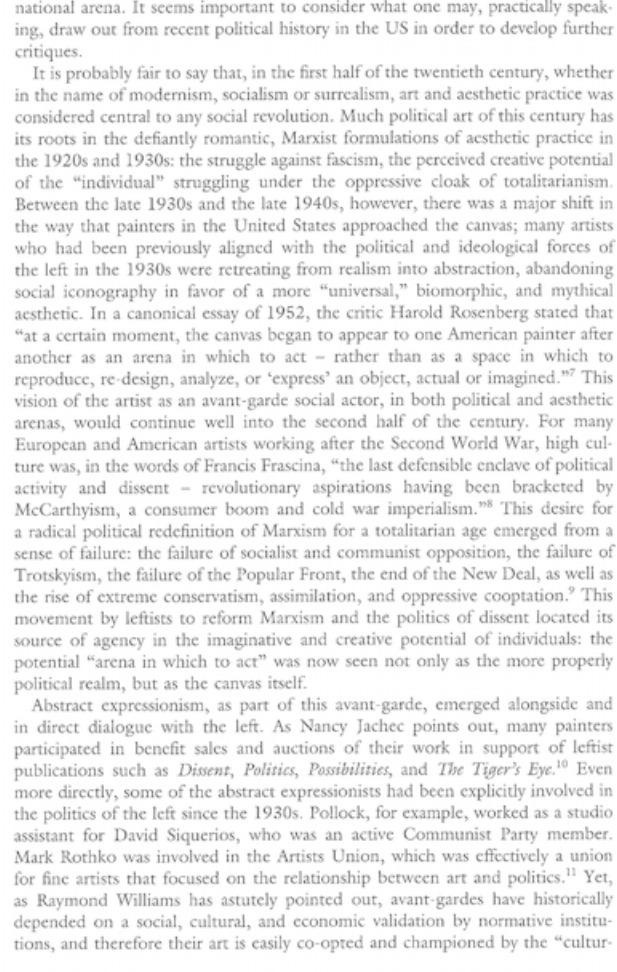national arena. It seems important to consider what one may, practically speak ing, draw out from recent political history in the US in order to develop further critiques. It is probably fair to say that, in the first half of the twentieth century, whether in the name of modernism, socialism or surrealism, art and aesthetic practice was considered central to any social revolution. Much political art of this century has its roots in the defiantly romantic, Marxist formulations of aesthetic practice in the 1920s and 1930s: the struggle against fascism, the perceived creative potential of the "individual" struggling under the oppressive cloak of totalitarianism. Between the late 1930s and the late 1940s, however, there was a major shift in the way that painters in the United States approached the canvas; many artists who had been previously aligned with the political and ideological forces of the left in the 1930s were retreating from realism into abstraction, abandoning social iconography in favor of a more "universal," biomorphic, and mythical aesthetic. In a canonical essay of 1952, the critic Harold Rosenberg stated that "at a certain moment, the canvas began to appear to one American painter after another as an arena in which to act - rather than as a space in which to reproduce, re-design, analyze, or 'express' an object, actual or imagined." This vision of the artist as an avant-garde social actor, in both political and aesthetic arenas, would continue well into the second half of the century. For many European and American artists working after the Second World War, high cul- ture was, in the words of Francis Frascina, "the last defensible enclave of political activity and dissent - revolutionary aspirations having been bracketed by Mccarthyism, a consumer boom and cold war imperialism." This desire for a radical political redefinition of Marxism for a totalitarian age emerged from a sense of failure: the failure of socialist and communist opposition, the failure of Trotskyism, the failure of the Popular Front, the end of the New Deal, as well as the rise of extreme conservatism, assimilation, and oppressive cooptation." This movement by leftists to reform Marxism and the politics of dissent located its source of agency in the imaginative and creative potential of individuals: the potential "arena in which to act" was now seen not only as the more properly political realm, but as the canvas itself. Abstract expressionism, as part of this avant-garde, emerged alongside and in direct dialogue with the left. As Nancy Jachec points out, many painters participated in benefit sales and auctions of their work in support of leftist publications such as Dissent, Politics, Possibilities, and The Tiger's Eye. 10 Even more directly, some of the abstract expressionists had been explicitly involved in the politics of the left since the 1930s. Pollock, for example, worked as a studio assistant for David Siquerios, who was an active Communist Party member. Mark Rothko was involved in the Artists Union, which was effectively a union for fine artists that focused on the relationship between art and politics." Yet, as Raymond Williams has astutely pointed out, avant gardes have historically depended on a social, cultural, and economic validation by normative institu- tions, and therefore their art is casily co-opted and championed by the "cultur







